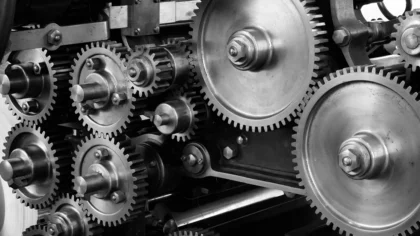Emerging medical device trends deal with tackling the risk of infections, leveraging health data, and automating manual processes. Medical device manufacturers are using technologies such as artificial intelligence (AI), analytics, robotics, and immersive technologies, among others.
These trends improve the efficiency and affordability of medical devices. This report provides an overview of top medical device trends and innovations in 2025. They range from wearables and the internet of medical things (IoMT) to 3D printing and medical waste management. Read more to explore how they impact your business.
Top 10 Medical Device Trends in 2025
- Wearables
- Medical Robots
- Immersive Technologies
- 3D Printing
- Internet of Medical Things
- Artificial Intelligence
- Cybersecurity
- Minimally Invasive Devices
- Medical Waste Management
- 5G
Methodology: How We Created the Medical Device Trend Report
For our trend reports, we leverage our proprietary StartUs Insights Discovery Platform, covering 5M+ global startups, 20K technologies & trends plus 150M+ patents, news articles, and market reports.
Creating a report involves approximately 40 hours of analysis. We evaluate our own startup data and complement these insights with external research, including industry reports, news articles, and market analyses. This process enables us to identify the most impactful and innovative trends in the medical device industry.
For each trend, we select two exemplary startups that meet the following criteria:
- Relevance: Their product, technology, or solution aligns with the trend.
- Founding Year: Established between 2020 and 2025.
- Company Size: A maximum of 200 employees.
- Location: Specific geographic considerations.
This approach ensures our reports provide reliable, actionable insights into the medical device innovation ecosystem while highlighting startups driving technological advancements in the industry.
Innovation Map outlines the Top 10 Medical Device Trends & 20 Promising Startups
For this in-depth research on the Top Medical Device Trends & Startups, we analyzed a sample of 4000+ global startups & scaleups. The Medical Device Innovation Map created from this data-driven research helps you improve strategic decision-making by giving you a comprehensive overview of the medical device industry trends & startups that impact your company.
Tree Map reveals the Impact of the Top 10 Medical Device Trends
The Medical Device Tree Map highlights the Top 10 Medical Device Trends. Startups and scaleups are developing wearable and IoMT solutions for personalized healthcare. Automation drives the adoption of medical robotics, AI, and immersive technologies in the medical device sector.
Startups are also creating minimally invasive devices for procedural challenges and patient safety. They leverage 3D printing for rapid prototyping. Medical device manufacturers are transitioning to more responsible operations through medical waste management.
Global Startup Heat Map covers 4063 Medical Device Startups & Scaleups
The Global Startup Heat Map showcases the distribution of 4000+ exemplary startups and scaleups analyzed using the StartUs Insights Discovery Platform. It highlights high startup activity in the United States and Europe, followed by India. From these, 20 promising startups are featured below, selected based on factors like founding year, location, and funding.
Want to Explore Medical Device Innovations & Trends?
Top 10 Medical Device Trends in 2025
1. Wearables
The global wearable medical devices market was valued at USD 42.74 billion in 2024 and is expected to grow at a CAGR of 25.53% from 2025 to 2030.
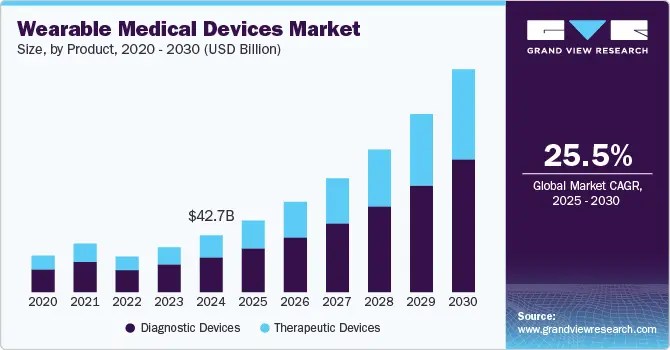
Credit: Grand View Research
Advances in circuit miniaturization enable companies to develop various wearables such as ECG monitors, biopatches, smart glasses, psychological monitoring devices, etc. They collect data on users’ health and vitals required for better healthcare delivery and improved health control.
Moreover, this allows doctors to provide remote treatments while being able to continuously track the patient’s health. Consequently, wearable medical devices enable non-invasive diagnosis and improve prognosis efficiency for medical emergencies.
Aidmed develops a Chest-worn Portable Device
Polish startup Aidmed develops a chest-worn portable device. The startup’s wearable recorder, Aidmed One, uses biosensors to record physiological parameters like blood pressure, temperature, and electrocardiogram (ECG). It then uses AI to turn these data into actionable insights into patient conditions.
Gate Science offers a Pain-controlling Wearable
US-based startup Gate Science offers a pain-controlling wearable device. The startup’s product, RELAY, combines pharmacologic blockade and neuromodulation capabilities in a single multimodal device.
Further, Gate Science’s companion app allows patients to control these signaling mechanisms. The startup’s solution offers doctors and patients an alternative to post-surgery pain-killing narcotics.
2. Medical Robots
Medical robots are replacing conventional surgery methods for better targeting and patient safety. For example, robot-assisted laparoscopic surgeries ensure that patients undergo smaller incisions, less blood loss, and recover faster.
On the other hand, surgeons benefit from improved ergonomics and dexterity in comparison in comparison to traditional laparoscopy. Hospitals and clinics now also deploy disinfecting robots, allowing health providers to focus on patient engagement. Lastly, microbots and nanobots to achieve target-based treatments.
Further, the global medical robotics market is expected to grow from USD 10.1 billion in 2024 to USD 31.3 billion by 2035, with a CAGR of 10.8% during the forecast period.
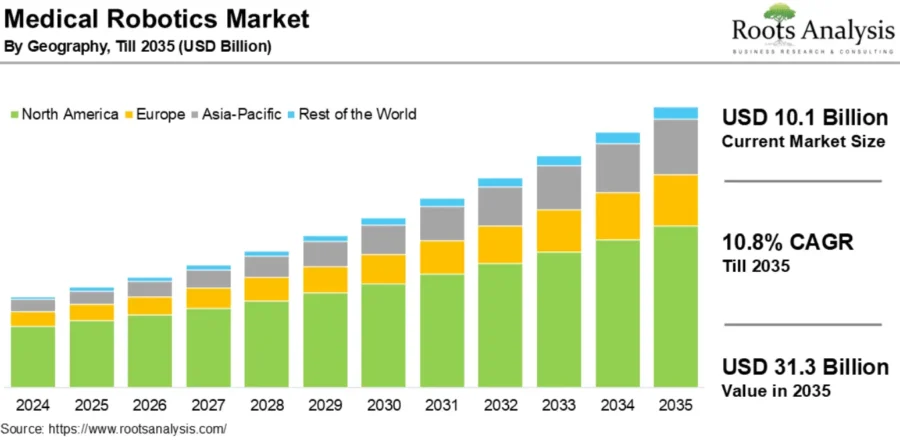
Credit: Root Analysis
RIF Robotics automates Surgical Tray Preparation
US startup RIF Robotics creates a robotic system that automates surgical tray preparation. This system uses computer vision and robotics to identify, inspect, and handle surgical instruments.
It improves sterile processing productivity and reduces preparation errors, which prevents operating room delays and patient infections. The startup makes the instrument reprocessing pipeline smarter to ensure hospitals have a steady supply of clean and functional surgical instruments.
Theranautilus provides Oral Healthcare Nanobots
Indian startup Theranautilus provides oral healthcare nanobots. The startup’s magnetic bots, BIO BOTS, feature lacings of bioactive components that are capable of reaching the dentinal tissues.
It permanently treats tooth hypersensitivity and promotes tooth regeneration. Dentists leverage the startup’s bots to automate intelligent targeting of drugs for oral diseases.
Further, Theranautilus secured USD 1.2 million in funding led by Pi Ventures.
3. Immersive Technologies
The immersive technology in the healthcare market was valued at USD 1.4 billion in 2024. It is projected to reach USD 15.1 billion by 2037, with a CAGR of 20.2% from 2025 to 2037.
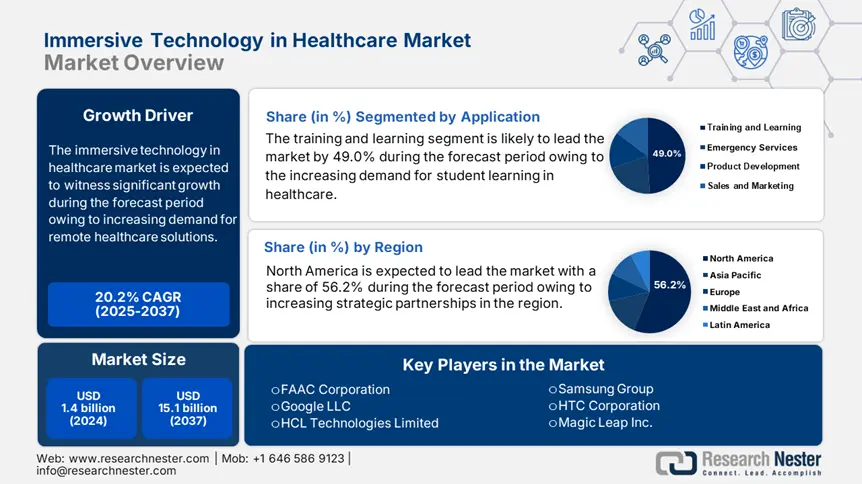
Credit: Research Nester
Advances in medical devices produce images and videos with greater resolution, but they are still static. Immersive technologies overcome this limitation and provide a first-person perspective.
Startups are leveraging virtual reality (VR), augmented reality (AR), and extended reality (XR) in medical device manufacturing to improve product design.
These technologies also improve the quality of care delivery while improving rehabilitation and engagement. For physicians, immersive technologies provide better decision support.
CleverPoint develops EEG/EMG, ECG Neurofeedback Device
Polish startup CleverPoint offers hardware that leverages VR-integrated wearables to decode brain processes. Its product, CleverPoint, captures and assesses patient reactions to VR content through neurofeedback. It includes models like CleverPoint 6 and CleverPoint 12, each varying in electrode count. These devices have built-in microphones, headphones, and a battery lasting up to 20 hours.
Further, CleverPoint incorporates sensors such as a three-axis gyro, accelerometer, magnetometer, and ambient light sensors. It gathers biofeedback for professionals to analyze patient responses to virtual environments. This approach advances the understanding and management of brain processes.
ViRe Instruments advances 3D Bioimaging Visualization
Spanish startup ViRe Instruments offers a VR headset and a platform that allows doctors to easily load and view DICOM files in 3D from new perspectives which is not possible with traditional views. It also provides an ultrasound module to view pre-natal images in VR or share with family in AR/VR, supporting major ultrasound machine brands. The startup’s core tools include measurements, region selection, segmentation, and cutting planes.
Specialized modules are available for areas like vascular surgery and oncology, tailored to each department’s needs. Additionally, ViRe Instruments’ ultrasound module allows viewing pre-natal images in VR and sharing with family in AR/VR, providing an engaging new way to experience ultrasound scans.
4. 3D Printing
The 3D printing medical devices industry is expected to grow from USD 3.9 billion in 2024 to USD 30.6 billion by 2035, with a CAGR of 20.6% from 2025 to 2035. The Asia-Pacific region will likely experience significant growth due to advancements in medical technology and rising healthcare expenditures.
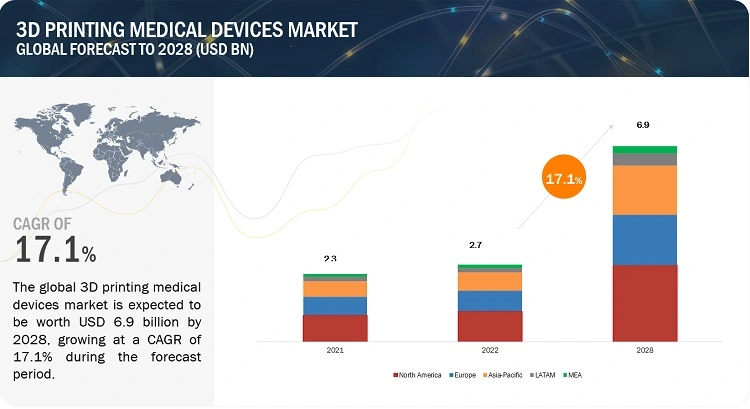
Credit: Markets and Markets
3D printing or additive manufacturing provides an opportunity to better integrate anatomical and pathological structures in the design of medical devices. For instance, this enhances the fit of implants to body parts. Additive manufacturing also presents better scaffolds for pre-surgical planning and training.
On the other hand, it enables the patient-specific and cost-efficient production of medical devices. Further, rapid prototyping makes it possible for manufacturers to create medical devices at high speed, closing the demand-supply gap.
VisionAir Solutions creates 3D-printed Silicone Stents
US-based startup VisionAir Solutions creates 3D-printed silicone stents. The startup’s production process combines 3D printing with traditional medical-grade silicone injection.
The startup’s stents help patients with central airway obstructions to breathe easier. Its cloud-based platform enables treating pulmonologists to design these stents specific to each patient.
Spectroplast manufactures 3D-printed Biocompatible Devices
Swiss startup Spectroplast offers silicon-based biocompatible devices. The startup’s 3D printing technology enables the direct fabrication of pure silicones without the use of molds.
Medical device manufacturers leverage this silicon additive manufacturing (SAM) technology to save costs and develop on-demand production capabilities. It facilitates the production of anatomical devices, implants, and orthotics among other devices.
Further, Spectroplast completed its Series A financing round, led by HZG Group.
5. Internet of Medical Things
The IoMT refers to a network of connected medical devices for the transmission and analysis of health data. In-home IoMT devices allow patients to share their medical data with their primary care providers or hospitals.
On-body IoMT uses wearables to track vital data. Hospitals also use connected wearables and devices to monitor patient movements and obtain their vitals. Its benefits include more accurate diagnoses and cost-effective care.
Moreover, the global IoMT market was valued at USD 230.69 billion in 2024 and is expected to grow at a CAGR of 18.2% from 2025 to 2030. Healthcare providers have adopted IoMT at an 85% rate, using it for remote patient monitoring and smart hospitals.
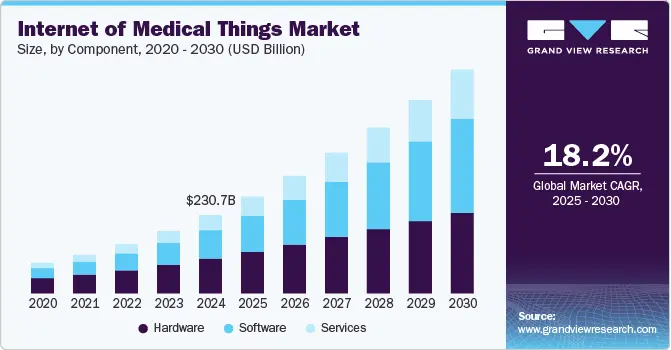
Credit: Grand View Research
Orbicor Technologies offers a Cardiovascular Management Platform
Costa Rican startup Orbicor Technologies builds UnnoMed, a cardiovascular management platform. The platform provides differentiated clinical data using IoMT medical devices.
This data is complementary to what is already available to cardiovascular patients and enables ongoing control and optimizes the treatment of their conditions. This way, the platform supports healthcare providers in detecting the early stage and evolution of cardiovascular diseases (CVD).
EloCare creates a Connected Menopause Care Device
Singaporean startup EloCare develops a connected menopause care device. The startup’s wearable, Elo, continuously monitors symptoms and collects data on health parameters.
Clinicians utilize the data to create personalized health profiles. This improves the delivery of lifestyle or medical intervention for women undergoing menopause.

6. Artificial Intelligence
Artificial intelligence improves the processing and analysis of large amounts of data that medical devices gather. With patient-specific health data, companies use AI to identify diseases or the onset of medical conditions. Further, AI enables predictive analysis and monitors treatment efficiency.
Medical device manufacturers are also integrating AI technologies like computer vision to accelerate diagnosis and enable robotic surgery. AI also finds application in automating and optimizing production workflows.
Moreover, the AI in medical devices market is expected to grow significantly, reaching USD 35.5 billion by 2029, with a CAGR of 29.9%.
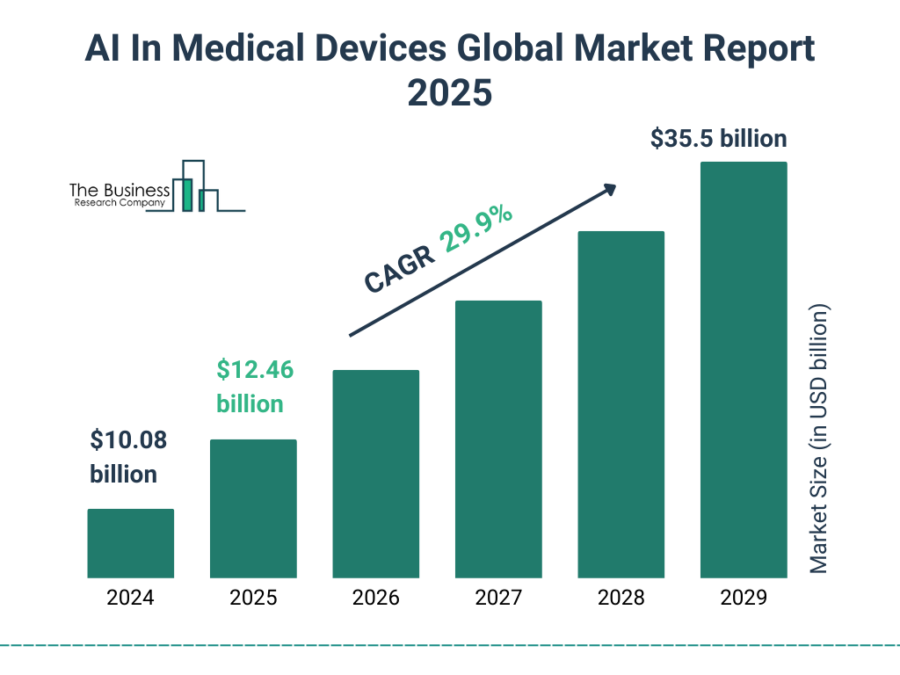
Credit: The Business Research Company
Nightingale provides a Smart Wristband
Taiwanese startup Nightingale offers an infection prediction smart wristband. The AI-enabled wearable device, HEARThermo, continuously monitors the changes in body temperature and heart rate.
HEARThermo’s AI generates an analysis report that allows healthcare providers to predict infections. This allows public health workers to monitor suspected cases during an infectious outbreak.
PneumoWave develops a Smart Biosensor
UK-based startup PneumoWave devises a chest-worn smart biosensor. The biosensor captures respiratory data and the startup’s platform analyses it using machine learning algorithms.
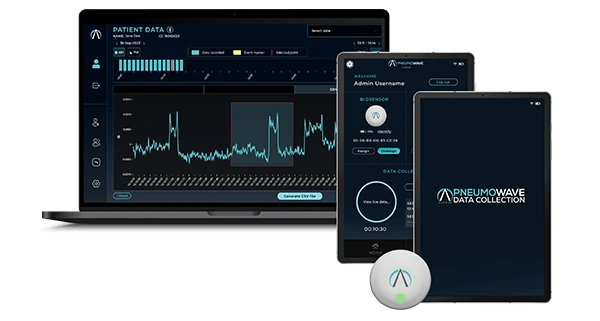
This improves the monitoring of chronic obstructive pulmonary disease (COPD). It detects early signs of deterioration and notifies the patients and physicians. This allows rapid treatment and reduces or shortens hospital admissions.
7. Cybersecurity
Healthcare facilities are one of the primary targets of malicious hackers. Moreover, the adoption of cloud-based and connected medical devices makes the industry more vulnerable to cyberattacks. Thus, startups offer cybersecurity solutions tailored for medical devices.
These solutions allow manufacturers, hospitals, and patients to promptly identify any network or device anomalies and mitigate risk. By protecting medical devices from deliberate malfunctioning, cybersecurity solutions prevent threats to patient lives.
The medical device cybersecurity solutions market has grown rapidly in recent years. It will expand from USD 13.29 billion in 2024 to USD 16.71 billion in 2025, with a CAGR of 25.7%. By 2029, the market will reach USD 41.25 billion, with a CAGR of 25.3%.
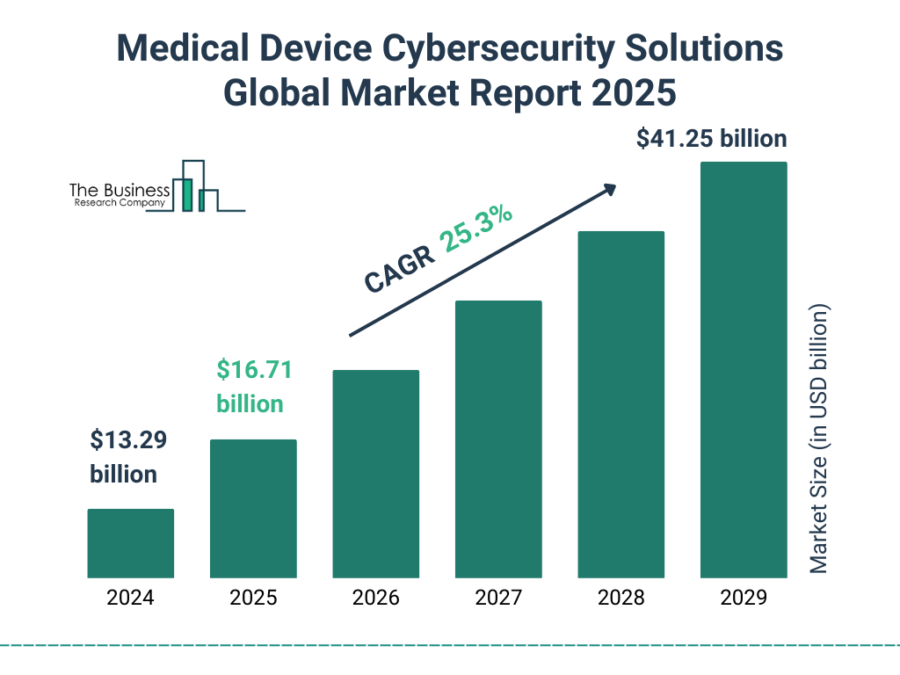
Credit: The Business Research Company
Culinda simplifies Medical Device Security Management
US-based startup Culinda offers end-to-end medical device security management. It uses AI to prevent medical devices from cyberattacks by enabling real-time defenses.
Further, the startup uses blockchain to provide continuous access to device information such as communication sources, device inventory mapping, etc. Culinda’s solution allows hospitals to securely manage all medical assets.
PROREGIA develops End-to-End Framework Modules for Connected Medical Devices
PROREGIA is a Swiss startup that specializes in cybersecurity for connected medical devices. Their modules facilitate the integration into the IoMT, emphasizing security separation from business logic. The startup’s end-to-end modules focus on device-specific cryptographic operations, ensuring attacks don’t scale. Its asset management feature tracks devices, preventing counterfeiting and offering insights into device metrics.
Over-the-air firmware updates enhance device usability, monitored by asset management. PROREGIA’s 3rd party interaction framework ensures secure, traceable interactions for medical devices. Their app authentication solution defends against phishing, ensuring devices communicate only with official apps.
8. Minimally Invasive Devices
The minimally invasive surgery devices market is estimated at USD 36.50 billion in 2025. It is expected to reach USD 50.21 billion by 2030, with a CAGR of 6.59% during the forecast period from 2025 to 2030.
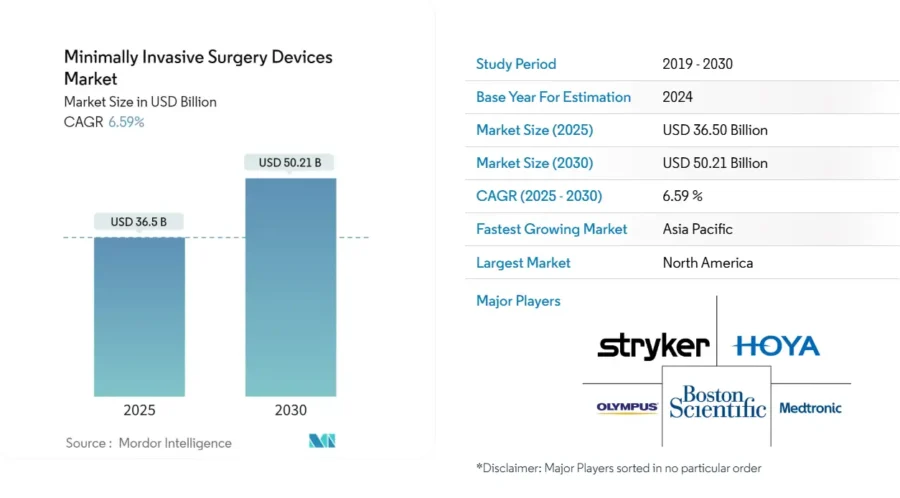
Credit: Mordor Intelligence
Minimally invasive surgery tackles the challenges of invasive surgery such as infection risks, large scars, and slower recovery rates. New techniques and devices allow surgeons to make smaller incisions across procedures such as endoscopy, laparoscopy, and robot-assisted surgeries.
Startups are integrating miniaturized sensors in the tips of the devices that provide feedback to the operating physician, such as with haptic vibrations. Moreover, minimally invasive devices reduce patient trauma and discomfort, infections, recovery times, and healthcare costs.
ReGelTec makes an Injectable Hydrogel Device
US-based startup ReGelTec develops injectable hydrogel devices. The startup’s system, Hydrafil, uses hydrogel technology to inject an implant for nucleus pulposus augmentation as a viscous fluid.
The liquid then converts into a solid cohesive hydrogel within the disc annulus, thereby effectively sealing the site and minimizing expulsion risks. Physicians leverage this minimally invasive system to develop spinal implants for chronic back pain patients.
Exubrion Therapeutics develops a Minimally Invasive Veterinary Device
Exubrion Therapeutics is a US-based startup that provides Synovetin OA, a minimally invasive veterinary device. It consists of microparticles of tin radionuclide.
The doctors inject these particles into the joints where they deactivate the inflammatory macrophages and treat synovitis without producing any side effects. This way, it enables veterinary doctors to provide targeted therapy for osteoarthritis.
9. Medical Waste Management
The increase in the use of medical devices and accessories leads to a growing waste problem. Manufacturers are playing a large role in the disposal of medical devices.
For example, startups are manufacturing high-quality materials such as recyclable electronics for use in biomedical applications. Other solutions monitor medical waste and identify processes to recycle or reuse medical devices.
Also, the medical waste management market was valued at USD 12.6 billion in 2024 and is expected to reach USD 27.63 billion by 2035, with a CAGR of 7.4% from 2025 to 2035.
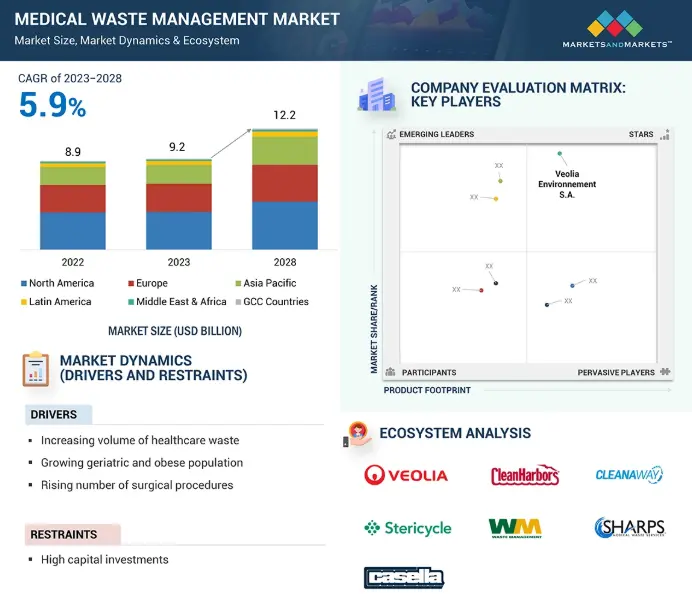
Credit: Markets and Markets
FLEEP Technologies creates Recyclable Biopatches
Italian startup FLEEP Technologies offers recyclable biopatches. The startup’s platform uses plastic films and carbon-based inks to develop these electronic patches that are thinner than human hair. As a result, they are easily recyclable and do not contribute to medical waste.
Polycarbin offers a Medical Waste Management Platform
US-based startup Polycarbin offers a medical waste management platform. It enables medical and life science laboratories to sort rigid plastics into clear and non-clear streams.
The startup also offers a mobile app that allows users to request pick-ups as well as track the recycling process. Polycarbin’s solution allows laboratories to send their end-of-life plastics for remanufacturing low-carbon lab products.
10. 5G
The global 5G in healthcare market was valued at USD 67.02 billion in 2024 and is expected to reach USD 1038.55 billion by 2034, with a CAGR of 32.80% from 2025 to 2034.
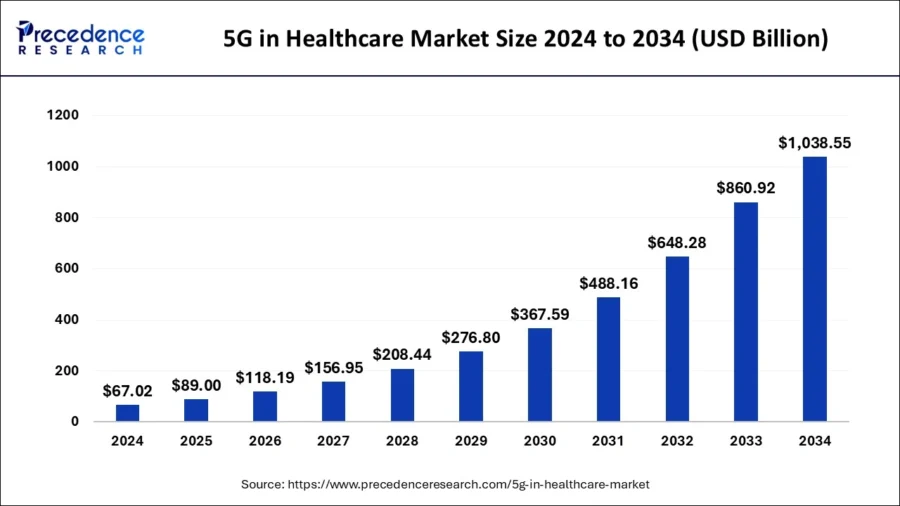
Credit: Precedence Research
5G technology is key to efficiently incorporating high-speed communication between medical devices and health infrastructure. For instance, low network latency during AR-assisted surgeries improves surgery quality. That is why medical device manufacturers are leveraging 5G for their connected products.
Its greater bandwidth and reliability ensure minimal lag between data collection and processing. Additionally, it allows doctors to convert images into holograms in real-time for more accurate diagnosis.
Spline makes a 5G-enabled Healthcare Platform
Indian startup Spline offers Dr. Spline, an integrated healthcare platform. It combines 5G and AI to provide a conversational user interface, predictive image and video analytics, and data security for any medical device. The platform connects the entire healthcare ecosystem and provides quick and easy access to solutions like AR-based surgical training.
Enquantum enhances Commercial Cloud Communication Systems
Equantum, an Israeli startup, provides field-programmable gate arrays (FPGAs) as a service for ultra-reliable low-latency communication (URLLC) in 5G networks. Its solution enhances commercial cloud communication systems and introduces a cryptographic approach tailored to the demands of 5G and future technologies.
It mitigates risks, enhances capabilities, and improves efficiency—all while maintaining low power consumption, a compact form factor, and minimal heat generation. The startup’s solution supports various applications, including medical.
Discover all Medical Device Trends, Technologies & Startups
The principal focus of the medical device industry is to improve the health of the patient in a cost-effective manner. Thus, AI and robotics along with wearables will continue to grow for improved healthcare delivery.
The growth of the healthcare service sector will also accelerate software as a medical service (SaMD). With the increase in remote treatment capabilities and immersive technologies, the R&D of mental health rehabilitation devices would be at the forefront.
The Medical Device Trends & Startups outlined in this report only scratch the surface of trends that we identified during our data-driven innovation and startup scouting process. Among others, extended reality, blockchain, and nanobots will transform the sector as we know it today.
Identifying new opportunities and emerging technologies to implement into your business goes a long way in gaining a competitive advantage. Get in touch to easily and exhaustively scout startups, technologies & trends that matter to you!


 WATCH THE VIDEO VERSION
WATCH THE VIDEO VERSION 
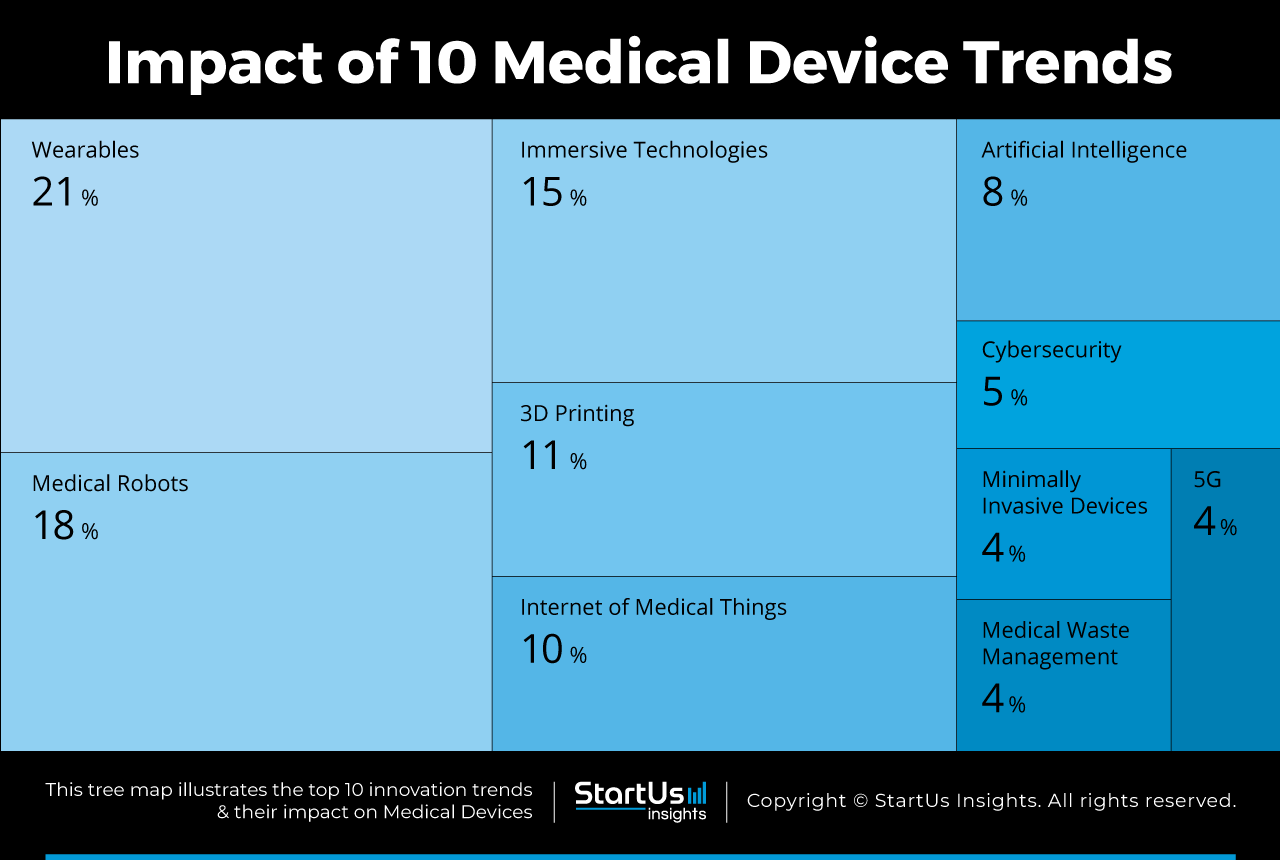
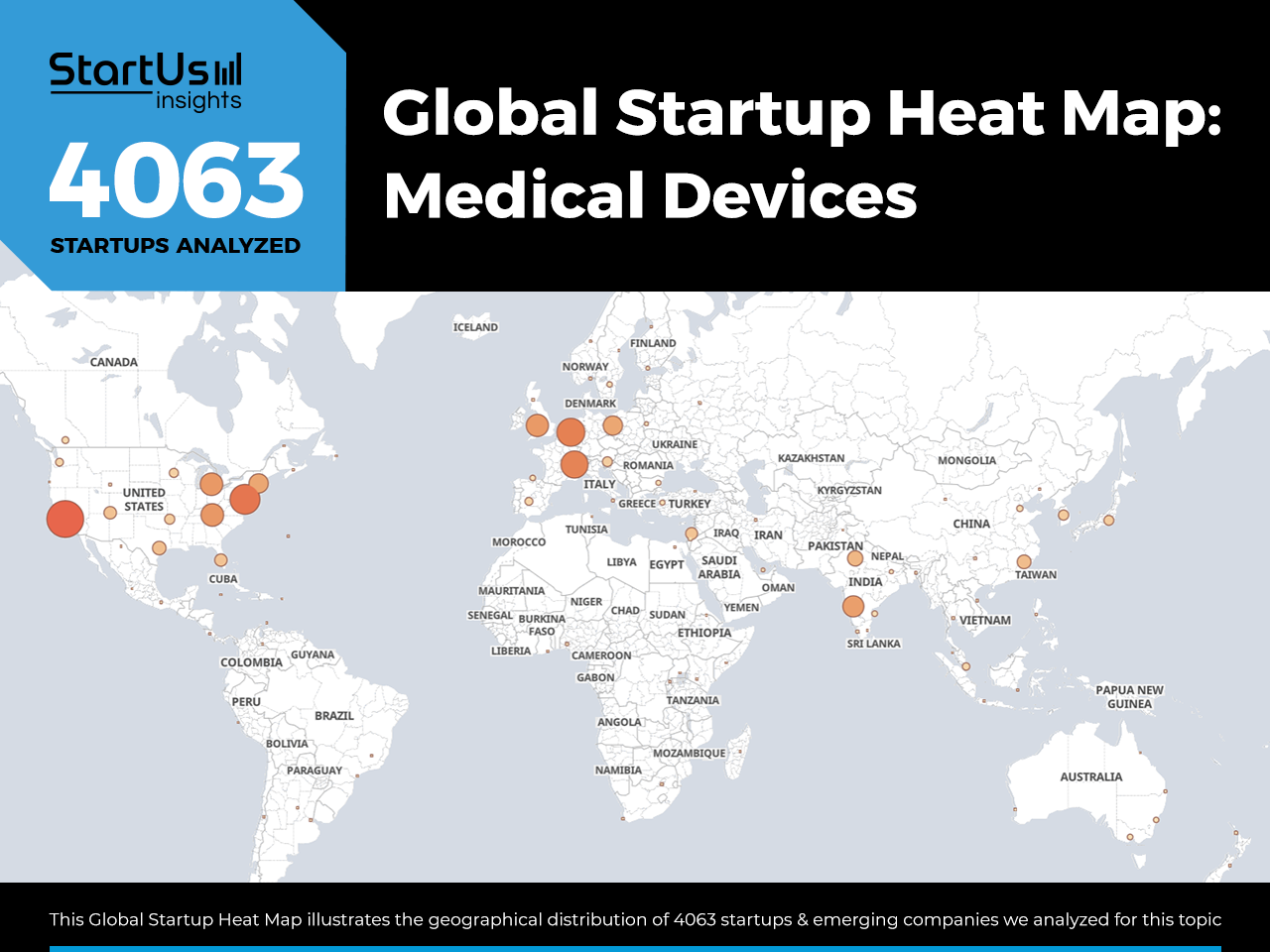

![AI in Healthcare: A Strategic Guide for Industry Leaders [2025-2030]](https://www.startus-insights.com/wp-content/uploads/2025/03/AI-in-Healthcare-SharedImg-StartUs-Insights-noresize-420x236.webp)





